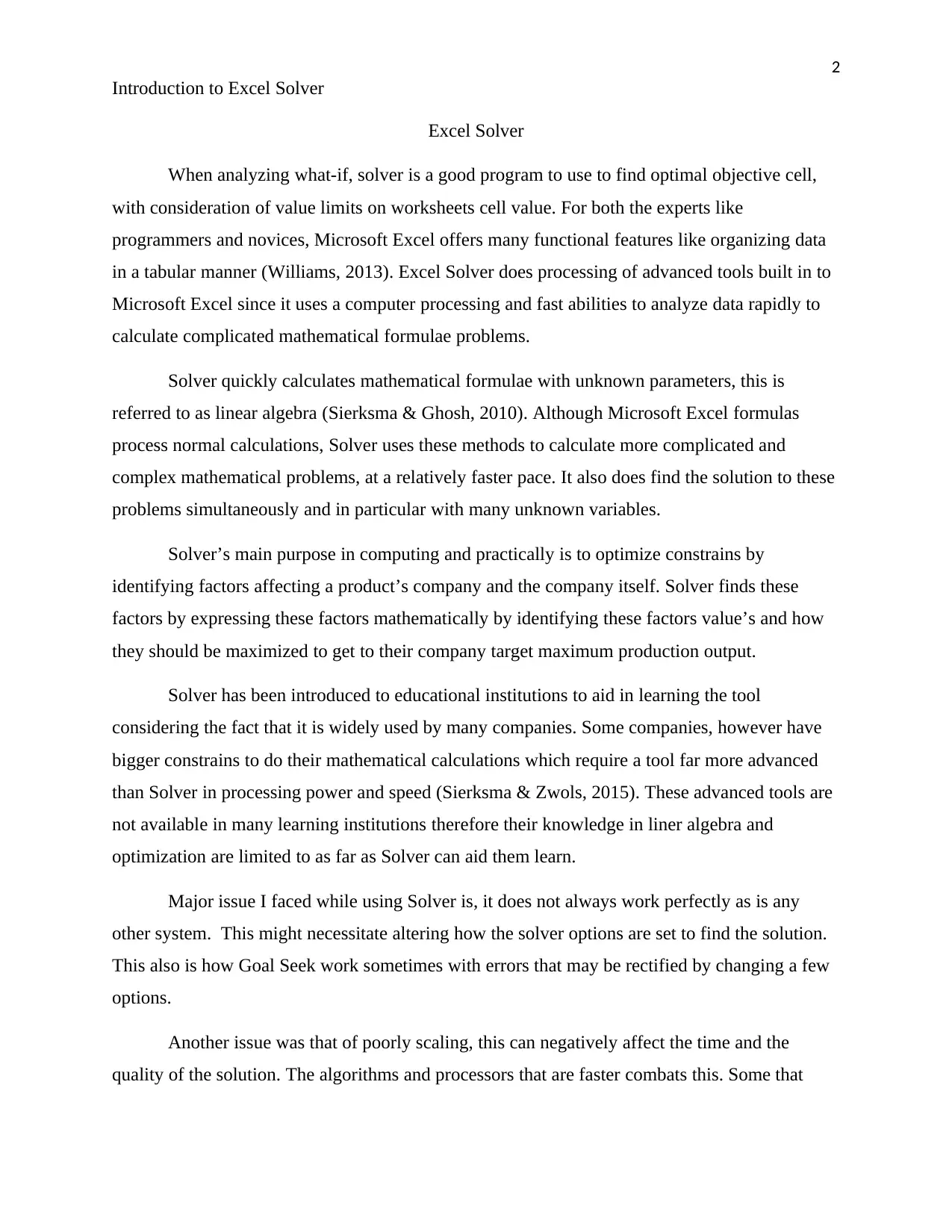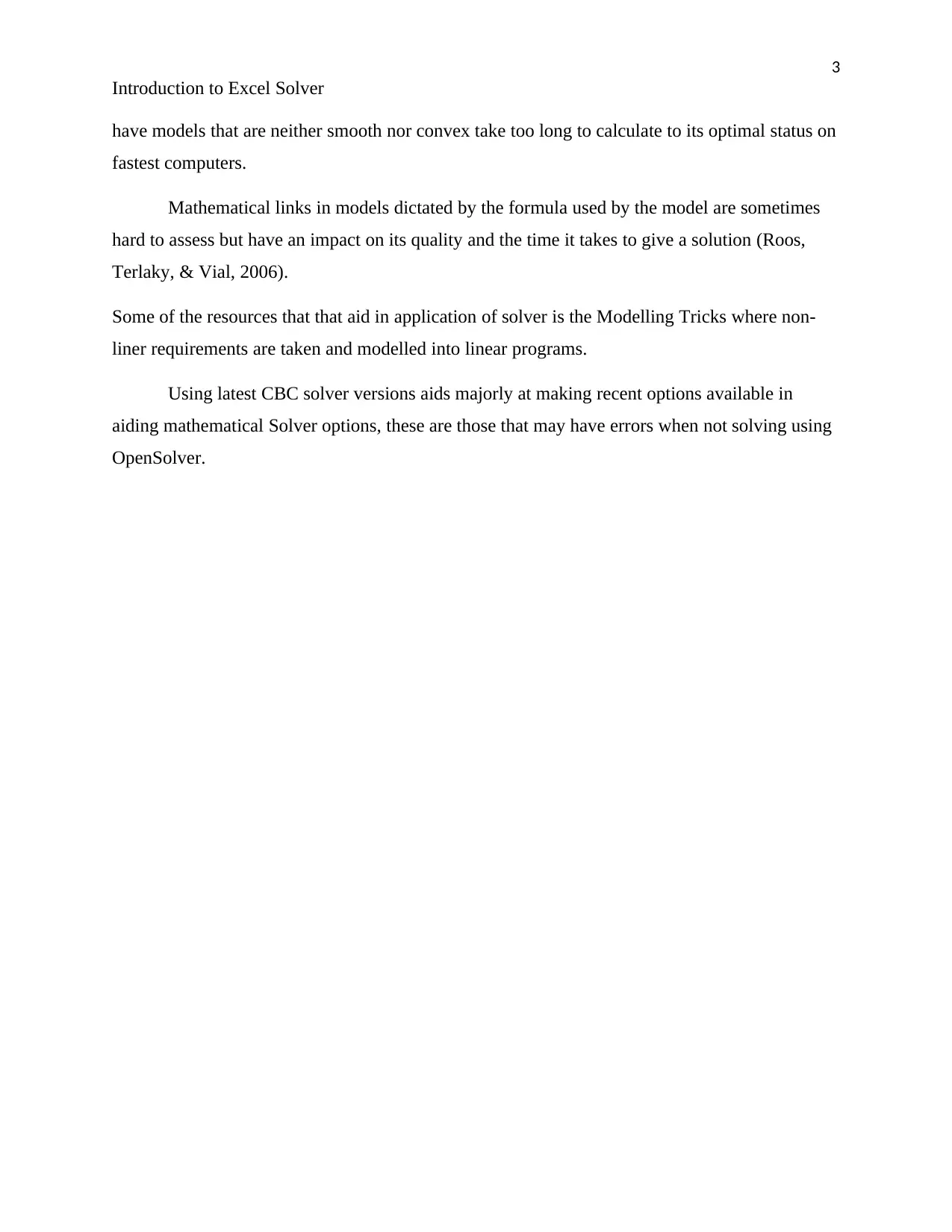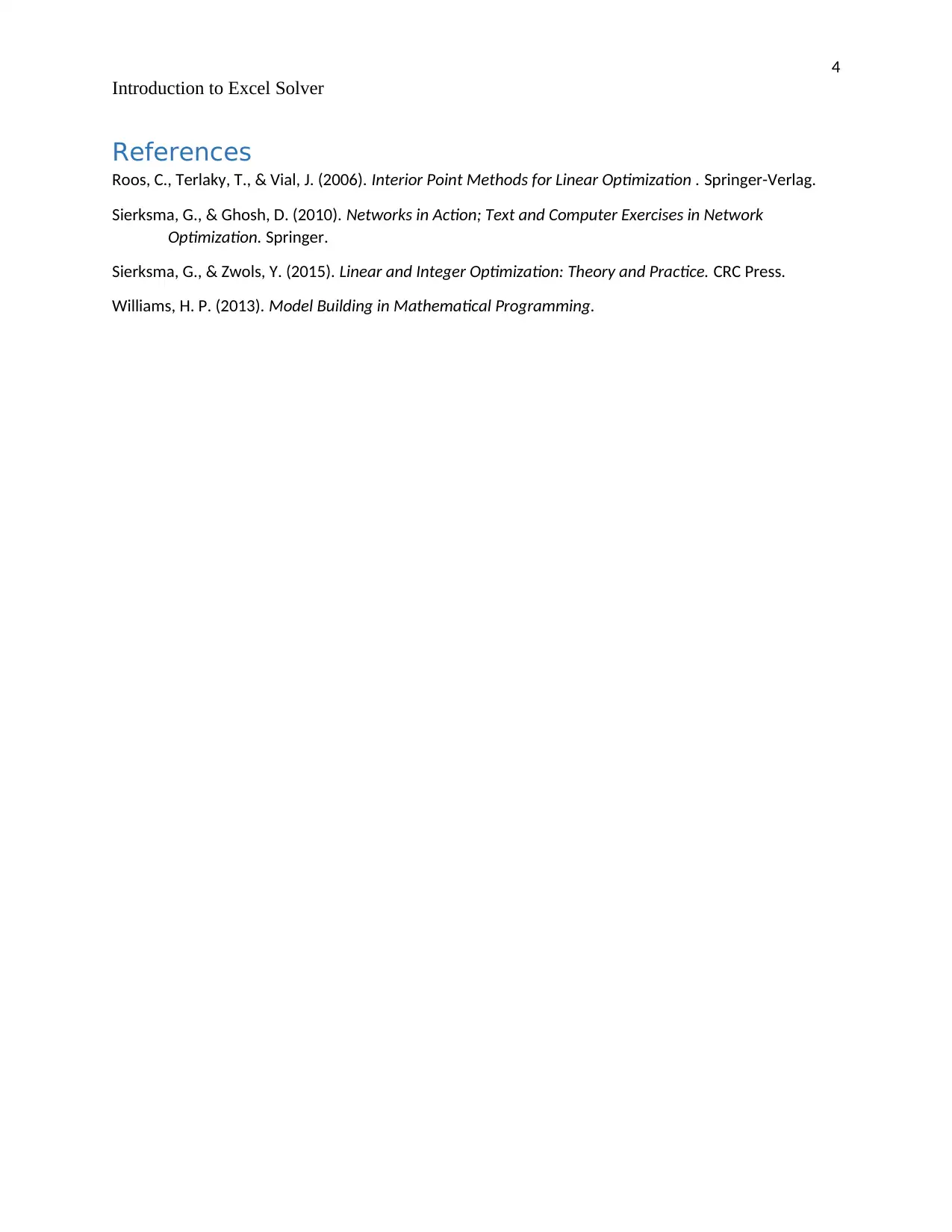Excel Solver: A Comprehensive Analysis of its Features and Uses
VerifiedAdded on 2023/06/03
|4
|643
|357
Homework Assignment
AI Summary
This assignment delves into the functionality of Excel Solver, a tool within Microsoft Excel used for optimization problems. It begins with an overview of Solver's capabilities, emphasizing its role in solving linear algebra problems and its use in various applications, particularly in business to optimiz...

1
Running head: Introduction to Excel Solver
Introduction to Excel Solver
Student name
Instructor name
Course name
Date
Running head: Introduction to Excel Solver
Introduction to Excel Solver
Student name
Instructor name
Course name
Date
Paraphrase This Document
Need a fresh take? Get an instant paraphrase of this document with our AI Paraphraser

2
Introduction to Excel Solver
Excel Solver
When analyzing what-if, solver is a good program to use to find optimal objective cell,
with consideration of value limits on worksheets cell value. For both the experts like
programmers and novices, Microsoft Excel offers many functional features like organizing data
in a tabular manner (Williams, 2013). Excel Solver does processing of advanced tools built in to
Microsoft Excel since it uses a computer processing and fast abilities to analyze data rapidly to
calculate complicated mathematical formulae problems.
Solver quickly calculates mathematical formulae with unknown parameters, this is
referred to as linear algebra (Sierksma & Ghosh, 2010). Although Microsoft Excel formulas
process normal calculations, Solver uses these methods to calculate more complicated and
complex mathematical problems, at a relatively faster pace. It also does find the solution to these
problems simultaneously and in particular with many unknown variables.
Solver’s main purpose in computing and practically is to optimize constrains by
identifying factors affecting a product’s company and the company itself. Solver finds these
factors by expressing these factors mathematically by identifying these factors value’s and how
they should be maximized to get to their company target maximum production output.
Solver has been introduced to educational institutions to aid in learning the tool
considering the fact that it is widely used by many companies. Some companies, however have
bigger constrains to do their mathematical calculations which require a tool far more advanced
than Solver in processing power and speed (Sierksma & Zwols, 2015). These advanced tools are
not available in many learning institutions therefore their knowledge in liner algebra and
optimization are limited to as far as Solver can aid them learn.
Major issue I faced while using Solver is, it does not always work perfectly as is any
other system. This might necessitate altering how the solver options are set to find the solution.
This also is how Goal Seek work sometimes with errors that may be rectified by changing a few
options.
Another issue was that of poorly scaling, this can negatively affect the time and the
quality of the solution. The algorithms and processors that are faster combats this. Some that
Introduction to Excel Solver
Excel Solver
When analyzing what-if, solver is a good program to use to find optimal objective cell,
with consideration of value limits on worksheets cell value. For both the experts like
programmers and novices, Microsoft Excel offers many functional features like organizing data
in a tabular manner (Williams, 2013). Excel Solver does processing of advanced tools built in to
Microsoft Excel since it uses a computer processing and fast abilities to analyze data rapidly to
calculate complicated mathematical formulae problems.
Solver quickly calculates mathematical formulae with unknown parameters, this is
referred to as linear algebra (Sierksma & Ghosh, 2010). Although Microsoft Excel formulas
process normal calculations, Solver uses these methods to calculate more complicated and
complex mathematical problems, at a relatively faster pace. It also does find the solution to these
problems simultaneously and in particular with many unknown variables.
Solver’s main purpose in computing and practically is to optimize constrains by
identifying factors affecting a product’s company and the company itself. Solver finds these
factors by expressing these factors mathematically by identifying these factors value’s and how
they should be maximized to get to their company target maximum production output.
Solver has been introduced to educational institutions to aid in learning the tool
considering the fact that it is widely used by many companies. Some companies, however have
bigger constrains to do their mathematical calculations which require a tool far more advanced
than Solver in processing power and speed (Sierksma & Zwols, 2015). These advanced tools are
not available in many learning institutions therefore their knowledge in liner algebra and
optimization are limited to as far as Solver can aid them learn.
Major issue I faced while using Solver is, it does not always work perfectly as is any
other system. This might necessitate altering how the solver options are set to find the solution.
This also is how Goal Seek work sometimes with errors that may be rectified by changing a few
options.
Another issue was that of poorly scaling, this can negatively affect the time and the
quality of the solution. The algorithms and processors that are faster combats this. Some that

3
Introduction to Excel Solver
have models that are neither smooth nor convex take too long to calculate to its optimal status on
fastest computers.
Mathematical links in models dictated by the formula used by the model are sometimes
hard to assess but have an impact on its quality and the time it takes to give a solution (Roos,
Terlaky, & Vial, 2006).
Some of the resources that that aid in application of solver is the Modelling Tricks where non-
liner requirements are taken and modelled into linear programs.
Using latest CBC solver versions aids majorly at making recent options available in
aiding mathematical Solver options, these are those that may have errors when not solving using
OpenSolver.
Introduction to Excel Solver
have models that are neither smooth nor convex take too long to calculate to its optimal status on
fastest computers.
Mathematical links in models dictated by the formula used by the model are sometimes
hard to assess but have an impact on its quality and the time it takes to give a solution (Roos,
Terlaky, & Vial, 2006).
Some of the resources that that aid in application of solver is the Modelling Tricks where non-
liner requirements are taken and modelled into linear programs.
Using latest CBC solver versions aids majorly at making recent options available in
aiding mathematical Solver options, these are those that may have errors when not solving using
OpenSolver.
⊘ This is a preview!⊘
Do you want full access?
Subscribe today to unlock all pages.

Trusted by 1+ million students worldwide

4
Introduction to Excel Solver
References
Roos, C., Terlaky, T., & Vial, J. (2006). Interior Point Methods for Linear Optimization . Springer-Verlag.
Sierksma, G., & Ghosh, D. (2010). Networks in Action; Text and Computer Exercises in Network
Optimization. Springer.
Sierksma, G., & Zwols, Y. (2015). Linear and Integer Optimization: Theory and Practice. CRC Press.
Williams, H. P. (2013). Model Building in Mathematical Programming.
Introduction to Excel Solver
References
Roos, C., Terlaky, T., & Vial, J. (2006). Interior Point Methods for Linear Optimization . Springer-Verlag.
Sierksma, G., & Ghosh, D. (2010). Networks in Action; Text and Computer Exercises in Network
Optimization. Springer.
Sierksma, G., & Zwols, Y. (2015). Linear and Integer Optimization: Theory and Practice. CRC Press.
Williams, H. P. (2013). Model Building in Mathematical Programming.
1 out of 4
Related Documents
Your All-in-One AI-Powered Toolkit for Academic Success.
+13062052269
info@desklib.com
Available 24*7 on WhatsApp / Email
![[object Object]](/_next/static/media/star-bottom.7253800d.svg)
Unlock your academic potential
© 2024 | Zucol Services PVT LTD | All rights reserved.




